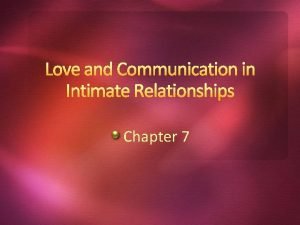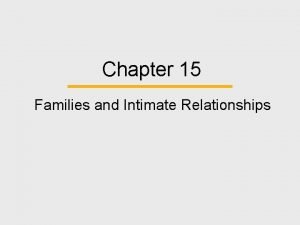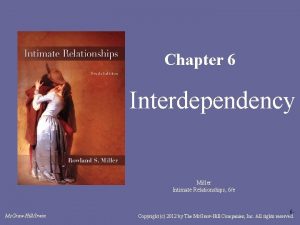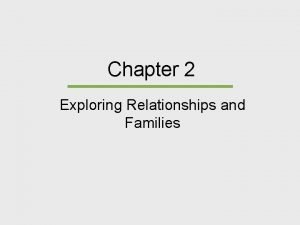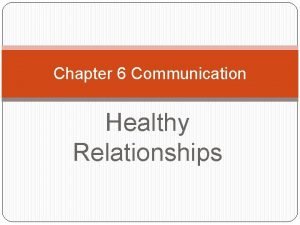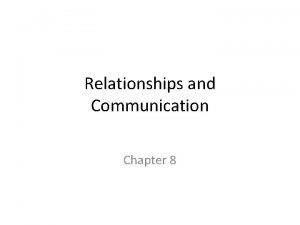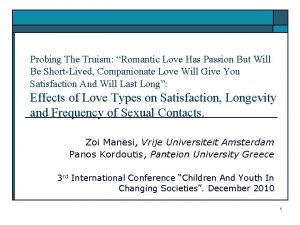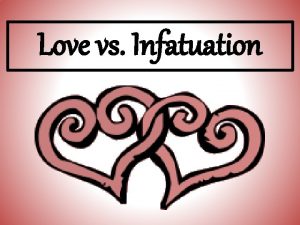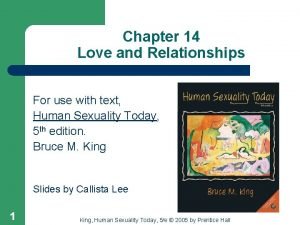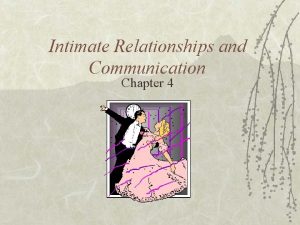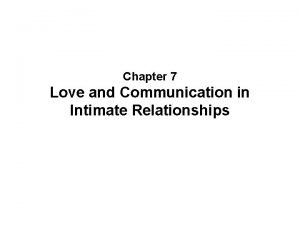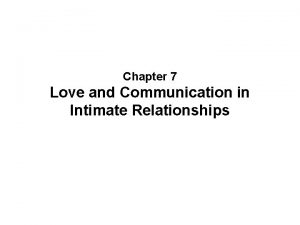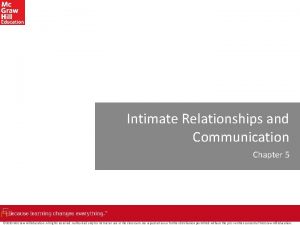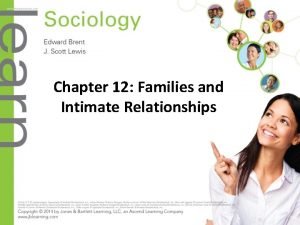Chapter Eight Love and Communication in Intimate Relationships
































- Slides: 32

Chapter Eight Love and Communication in Intimate Relationships

Love • • Exists in all cultures Exists in all ethnic groups Exists in all orientations Dual nature: – Feeling – Activity

Communication • Connects sexuality and intimacy • Sexual communication is tied to sexual satisfaction • Sexual communication is unique

Friendship and Love • Friendship is a strong foundation for strong love relationships • Difference between friends and lovers • Marriage

Love and Sexuality • Sexuality and love are intimately related in our culture • Our language connects love and sex • Sexual satisfaction is tied to relationship satisfaction • Level of intimacy and relationship duration are correlated with the decision to engage in sexual activity • Cultural environment and physical environment

Sex Outside of Committed Relationships • Young adult sex outside of marriage is now the norm • Values in America have shifted due to: – Contraception and abortion – Redefined gender roles – Alterations in demographics

Men, Women, Sex, and Love • Men separate sex and love more than women • Women value sex in the context of a relationship • Lesbians share sex less than heterosexual couples or gay men

Love Without Sex • Celibacy or asexuality • A purposeful choice rather than a sexual problem • 4% men and 14% women • Emphasis on friendship and other relationship qualities

Styles of Love: Lee • • • Eros: love of beauty Mania: obsessive love Ludus: playful love Storge: companionate love Agape: altruistic love Pragma: practical love

The Triangular Theory of Love • Theory developed by Robert Sternberg • Emphasizes the dynamic quality of love relationships Intimacy Passion Commitment

The Components of Love: Ten Signs of Intimacy • Wanting to promote your partner’s welfare • Feeling happiness with your partner • Holding your partner in high regard • Being able to count on your partner in time of need • Being able to understand each other

The Components of Love (cont. ) • Sharing yourself and your possessions with your partner • Receiving emotional support from your partner • Giving emotional support to your partner • Being able to communicate with your partner about intimate things • Valuing partner’s presence in your life

Kinds of Love: Sternberg • Liking – Intimacy only • Infatuation – Passion only • Romantic Love – Intimacy and passion • Companionate Love – Intimacy and commitment • Fatuous Love – Passion and commitment • Consummate love – Intimacy, passion, and commitment • Empty love – Commitment only • Nonlove – Absence of all three

Infant-Caregiver Attachment • Bond depends on attachment object’s responsiveness • Infant happier in attachment object presence • Shares discoveries with attachment object. Coos, talks baby talk • Feeling of oneness with attachment object Romantic love • Feelings are related to lover’s interest • Happier when lover is present • Shares experiences with lover • Lovers coo, talk baby talk • Feeling of oneness with lover

Components of Attachment • Attachment style endures across ones life • Depends upon security and safety • Open acceptance and honesty

Types of Attachment • Secure attachments – Find it relatively easy to get close to other people • Anxious/ambivalent attachment – Believe that other people didn’t get as close as they themselves wanted • Avoidant attachments – Feel discomfort being close to other people

Unrequited Love • Love is not returned • Causes distress to all involved • Perspectives differ between the people who offer love and those who do not reciprocate

Jealousy • Jealousy does not prove the existence of love • Jealousy is painful • Jealousy can destroy or cement a relationship • Jealously is linked to violence

Jealousy • Aversive response to a real or imagined involvement with a third person • Absence may indicate relationship problems • Occurs where there are commitments in a relationship • Men and women differ in reported attempts to make their partner jealous

Managing Jealousy • Dealing with irrational suspicions can be difficult • Can work on underlying causes of our insecurity • If jealousy is well-founded, relationship may need to be modified or ended • Jealousy can be the catalyst for change

Extramarital Sex • Exists in dating, cohabiting, and marital relationships • Extramarital sex in exclusive marriages is related to three factors: – Stronger sexual interests – More permissive sexual values – Greater sexual opportunities – Weaker marital relationships

Making Love Last: From Passion to Intimacy • Intimate love: Each person knows they can count on the other • Commitment: Based on conscious choices rather than transitory feelings • Caring: Involves making another person’s needs as important as your own • Self-disclosure: Revealing ourselves—our hopes, our fears, our thoughts to deepen understanding and intimacy

The Nature of Communication • Involves conveying symbols, words, gestures, movements • Goal of establishing human contact, exchanging information, and reinforcing or changing attitudes and behaviors

Contexts of Communication • Cultural context – the language, values, beliefs, and customs in which communication takes place • Social context – the roles we play in society • Psychological context – how people communicate based on their personalities

Nonverbal Communication • The ability to correctly interpret nonverbal communication is important – Most of our “feeling” communication is nonverbal • 3 important factors: – Proximity: nearness in physical space – Eye contact: a symbol of interest – Touching: signals intimacy, closeness

Sexual Communication • Interpersonal sexual scripts provide “instructions” on how to behave sexually – In beginning relationships • Halo effect • Interest and opening lines • In some cases: establishing sexual orientation • First move and beyond • Directing sexual activity

Sexual Communication (Cont. ) • In established relationships – initiating sexual activity • For heterosexuals: men typically initiate more often • In same-sex relationships: typically the more emotionally expressive partner initiates

Gender Differences in Partner Communication • Women send clearer messages to their partners than do men • Men more than women tend to send negative messages or withdraw • Women tend to set the emotional tone of an argument • Women tend to use more qualifiers in their style of speaking

Developing Communication Skills • • • Talking about sex Keys to good communication Self disclosure Trust Feedback

Conflict and Intimacy • Conflict is natural in intimate relationships • A lack of arguing can signal trouble in a relationship • Conflict isn’t dangerous; it’s the manner in which it is handled that can hurt or help

Conflicts about Sex • Can result from a disagreement about sex • Can be used as a “scapegoat” for nonsexual problems • Can be a cover-up for deeper feelings such as inadequacy

Conflict Resolution • The way couples deal with conflict reflects and contributes to their happiness • Negotiating conflicts • Bargaining • Coexistence
 Define the relationship chapter 7
Define the relationship chapter 7 Define the relationship ch 7
Define the relationship ch 7 Family life today
Family life today The impact of incarceration on intimate relationships
The impact of incarceration on intimate relationships Plane shape
Plane shape What are the meanings of the eight shapes and eight colors
What are the meanings of the eight shapes and eight colors Zones of space communication
Zones of space communication Intimate zone in communication
Intimate zone in communication Love love jesus is love god greatest gift lyrics
Love love jesus is love god greatest gift lyrics Intimate family chapter 6
Intimate family chapter 6 Intimate family chapter 6
Intimate family chapter 6 Intimate family chapter 2
Intimate family chapter 2 Intimate family chapter 2
Intimate family chapter 2 Chapter 6 communication and relationships
Chapter 6 communication and relationships Intimate distance examples
Intimate distance examples Consultative language register examples
Consultative language register examples Dewgarden foaming intimate wash benefits
Dewgarden foaming intimate wash benefits Scary antonym
Scary antonym 01 me line intimate
01 me line intimate Abcde of intimate relationship
Abcde of intimate relationship Periwinkle doerfler
Periwinkle doerfler The salvation of man is through love and in love
The salvation of man is through love and in love That you must love me and love my dog summary
That you must love me and love my dog summary The different love languages
The different love languages Passionate love vs companionate love
Passionate love vs companionate love Passionate love vs companionate love
Passionate love vs companionate love Infatuation v love
Infatuation v love What is a crush
What is a crush Infatuation vs love
Infatuation vs love Love is blind corinthians
Love is blind corinthians Consummate love vs companionate love
Consummate love vs companionate love Types of love
Types of love Emotional love tank
Emotional love tank
